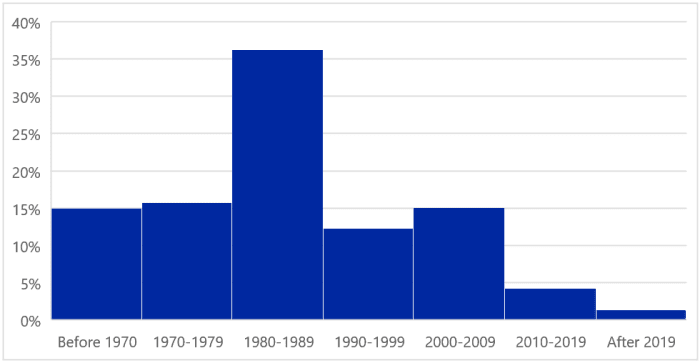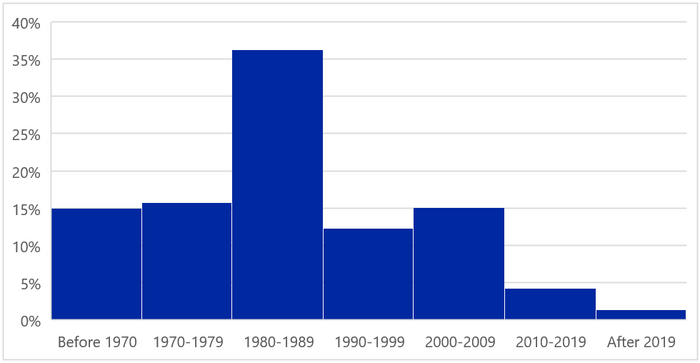As companies make a push to bring workers back to the office, office buildings built before the 1980s are going to face a reckoning, a new report from Moody’s says.
Businesses are working hard to lure people back to the traditional workplace after three years, for many, of remote and hybrid work.
But a reluctance among the working population to fully embrace the return to work is prompting many companies, from Airbnb to Zillow, to offer employees the flexibility to work from anywhere.
That spells trouble for commercial real estate, specifically office buildings, as tenants quit them. Coupled with debts coming due in the near term and a possible credit squeeze, the sector looks to be in danger of a crash landing.
Particularly for older office spaces, those built before the 1980s, which don’t offer the same levels of amenities and features that employees of late favor, Moody’s said in a new report, the writing may be on the wall.
“ ‘Almost two-thirds of the [New York metropolitan area’s] office buildings were built before the 1970s.’”
Properties built before the 1980s are at greater risk of becoming functionally obsolete “because generally speaking, if there were no significant renovations to the building, the amount of capital required to bring it ‘current’ and compete in today’s market would be costlier,” Nick Villa, an economist with Moody’s Analytics, told MarketWatch.
For instance, he said, consider the cost of replacing an outdated heating, ventilation and air-conditioning system to meet modern standards.
Commercial real estate facing a cliff
There is $5.6 trillion outstanding in commercial mortgages, according to the Mortgage Bankers Association.
Out of that pile, when looking only at specific real-estate assets like apartment, office, retail and industrial properties, the outstanding balance goes down to $4.4 trillion, with the remainder tied to construction projects, development loans, farmland and other categories. And 40% of this amount is held by institutions that are insured by the Federal Deposit Insurance Corp.
At the same time, around 16% of the $4.4 trillion in outstanding mortgages on commercial real estate are set to mature in 2023, Moody’s said, a quarter of which are backed by office properties.
These loans are vulnerable because they need to be refinanced. Their current loans were originated around a decade ago, when rates were lower. Refinancing now means that their new rates will be far higher. And if interest costs rise, borrowers will have to add equity to refinance or raise rent levels so that they can continue servicing the debt at adequate levels.
At the same time, banks are becoming more scrupulous about whom they lend to, tightening their lending standards amid a recent crisis in banking.
An attempt to bring remote employees back
Some employers are vacating old spaces and turning to shiny new properties that may be more enticing to employees exhibiting reluctance to return to the office.
A third of workers with jobs that can be done remotely are working from home all the time, according to a report from Pew Research Center.
Among those employees who have hybrid schedules, meaning they work some days from the office and the rest from home, 63% said their employers require them to come in person to work for a certain number of days per week or month.
Many employers are abandoning spaces built before the 1980s and earlier as they “seek to encourage workers back to the office with more modern amenities and design layouts,” Moody’s said.
“The vast majority of professional-services firms are gravitating toward two to three days in office in a [partially] remote work arrangement,” Kevin Fagan, head of commercial-real-estate analysis at Moody’s, said.
Employers are trying to make meetings more focused, he added, and seeking office spaces that present opportunities for people to meet and collaborate, alongside an ability to connect with remote employees.
“This isn’t always a way to lure employees back, as much as a way to make their limited time in the office more effective,” Fagan said.
But others are scaling back on how much space they’re renting, in preparation for a looming recession. Twitter and Liberty Mutual are in that group.
The worst-placed assets in commercial real estate are older office spaces, Moody’s said. “During this ongoing evolution, an economic slowdown could leave metros with a high stock of pre-1980 … properties vulnerable,” Moody’s stated.
Roughly 31% of office buildings in the top 80 metro areas in the U.S. were built before 1980, as seen in the chart below. And these are “particularly susceptible to an economic slowdown,” Moody’s said.

“Building Age Distribution for Top 80 Primary Office Metros” data as of the fourth quarter of 2022. Not adjusted for renovations.
Source: Moody’s Analytics CRE.
Metro areas with the highest concentrations of older offices
Who’s got the most office space dating back to before the ’80s?
Wichita, Kan., has the highest percentage of pre-1980s office stock, Moody’s said. The company calculated total square feet, not building count.
Wichita was followed by Syracuse, N.Y.; Oklahoma City, Okla.; Rochester, N.Y.; and New York City.
“Almost two-thirds of the [New York metropolitan area’s] office buildings were built before the 1970s,” Villa said. “Given the city’s extensive history, perhaps it’s not surprising that the majority of its office buildings tend to be relatively older compared [with] other metros.”
At the other end of the spectrum, Las Vegas had the lowest percentage of pre-1980s office stock. Other cities with a high share of newer office stock include Austin, Texas; suburban Virginia; Ventura County in Southern California; and the Raleigh-Durham area in North Carolina.
But the comparative youth of its office stock doesn’t necessarily mean that Las Vegas or Austin is immune to distress in a downturn, Moody’s noted.
Austin’s increasingly heavy concentration of tech companies could add to the “cyclical volatility of its economy,” Moody’s said. The tech sector has seen many layoffs over the past few months.
The rankings were not adjusted for renovated properties, Villa added.



